Seoul's Old Rhythm
The city of New Orleans is a very interesting place. Napoleon wanted to come to this city while confined in the St. Helena. Click here for story. Napoleon knew this city was developed by French settlers, and is located at the entrance of the Mississippi River from the Mexican Gulf. He was thus thinking of conquering the North American Continent starting from this city. Brilliant Napoleonic idea!!
For me, however, there is a different reason to love New Orleans.
- From 1948 to 1954, I attended all-male high school in Seoul, but there
were two elite high schools for girls near my school. Thus, we used to
be on the same street car while going to and from my school. According
to Confucian rules, boys were not allowed to talk to girls, but we
enjoyed looking at those girls.
In Japan, they did not change their high-school uniforms for more than 100 years. Their uniforms are very similar to those I am familiar with from my high-school years. Thus whenever I go to Tokyo or Osaka, I enjoy looking at those Japanese girls wearing their school uniforms, especially on the street cars, as you can see in the following photo I took in Osaka (2017).
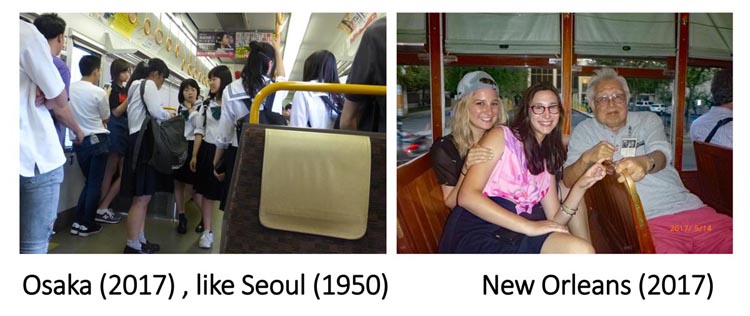
When I was in New Orleans in 2017, I spotted two American girls looking like students on a street car, and I proposed a photo with them. They cheerfully agreed as you can see in the above photo.
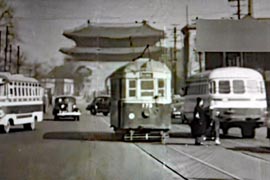
Seoul's Electric Car in 1960, and one of them in front of the History Museum on the ground of the Kyunghee Palace in Seoul. 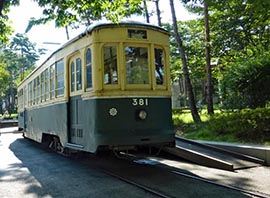
- Indeed, Seoul's Electric Cars meant many different things to many different
Koreans. As I said above, it was a place for boys and girls to meet without
talking.
For mothers in the country side, their life-time dream was to let their sons become the operators of those Electric Cars. During the Korean War, there were many boys in the Korean Marine Corps from the Jeju Island. During the bitter street battle in Seoul on September 28-29 (1950), they spotted Seoul's Electric Cars. They were holy animlals to those country boys. They rubbed their cheeks against the outside walls of those Electric Cars. Click here to see why there were so many Jeju boys in KMC during the Korean Wae.
I think it was 1941, when I went to Pyongyang, I could not understand how the Electric Cars could move without steam engines (like trains). I was too young to know about electric motors. When I came to Seoul in 1946, I knew why the Electric Cars need the electric cable and trolley above the car. The Cars were driven by electric motors. Yet, I could not understand why something was vibrating under the floor even while the Car did not move. All of you will remember hearing the sound from the floor. Did you know the source of this Rythm? It took me two years until 1948 to figure out what was going on.
- Most of Seoul's Electric Cars were manufactured by Japan's Mitsubishi,
and its trade mark was on the top of the speed-controller box. The Car
had six doors with two irreversible trolleys. It had a compressed air
brake system.
In Seoul, there were also small and older-looking four-door models with with one wheel base and ine revesible trolley. It has a hand-cranked brake system. Their speed controller box looked the same as that on the big Mitsubishi cars, but it had the General Electric trade mark.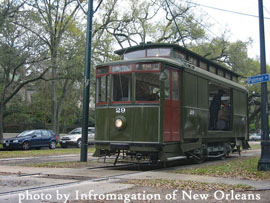
In Seoul, there were also street cars looking like this with a single wheel base. Thus, my assumption was that Mitsubishi originally took the GE model and improved it by adding an air brake system. The Rhythm from the floor generated by the compressor of the air brake system.
- Let us see how the brake system works. Every car has a tank for
compressed air, and the compressor feeds air to the tank to increase the
pressure. When the pressure in the tank becomes high enough, the system
turns off the compressor. When the air pressure in tank becomes low enough,
the compressor is turned on again. In this way, the air tank maintains the
required level of pressure. Then the brake system functions in the following
way.
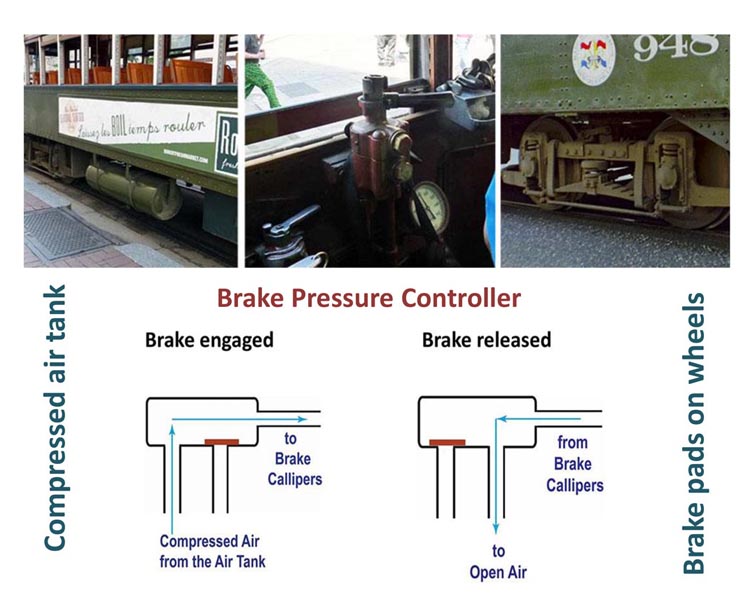
- Do you know who invented the brake system based on compressed air? He was George Westinghouse.
- He invented this brake system for trains.
- Using Tesla's idea, he initiated the DC-to-AC revolution.
- Click here to learn about him. He was one of the four great Americans from Pittsburgh, and I learned about him while I was spending the best four years (1954-58) of my life in Pittsburgh.
- I made my first trip to New Orleans in 1995. This city was created by early French settlers. They came with many African slaves. Those slaves created their own musical culture based on African rhythm. That is known as American jazz. The most talented jazz player was Louis Armstrong, and the city's airport is named after him. Thus, I was expecting to hear Jazz music and Jazz rhythm everywhere in the city.
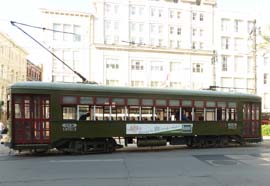
New Orleams trolley cars on
their St. Charls line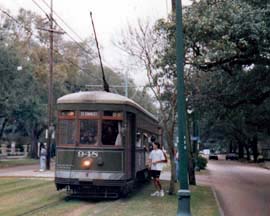
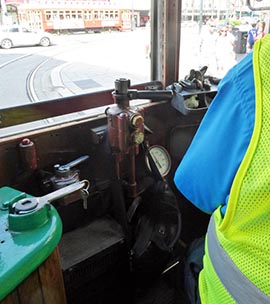
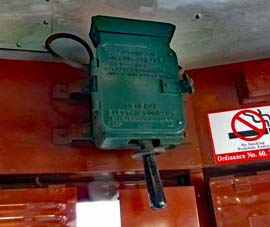
Circuit breaker manufactured by the General Electric of U.S.A. - However, the rhythm dearest to my heart was the sound of the air compressor coming from the bottom of the trolley cars in New Orleans. I used to hear the same sound when I was on Seoul's Electric Cars before coming to the United States in 1954.
The rhythm was coming from the air compressor for the brake system. As soon as I heard the rhythm, I looked at the driver's stand. Alas, the stand consists of the
- speed controller contained in an elliptic cylindrical
box on the left-hand side of the driver,
- pressure controller for the compressed-air brake system.
on the right-hand side of the driver.
- circuit breaker hangin directly above the speed controller.
This set up was exactly the same as that for Seoul's Electric Cars which served as wonder machines to so many Koreans for 60 years until 1963.
- Indeed, the compressor rhythm of New Orleans changed my assumption. Earlier I assumed that Japan's Mitsubishi imported the small trolley cars from the General Electric, and made it larger by adding the compressed-air brake system. Not true. Japenese engieers were ingeinouous enough to copy even the rhythm of their compressors from Americans.
I became agressive. I became interested in whether the cars of New Orleans were manufactured by the General Electric. I asked the operator whether he was driving a GE-made car. He said that he is too young to know who made his machine, and that his job is only to operate it safely. I looked at the top of the speed controller box, but it was resurfaced and gives no trace of its manufacturer.
I then looked at the circuit breaker above the speed controller box. It looked very old and its cover was green. Yes! This box says General Electric Company. The machine was manufactured by GE. Mitsubishi's air brake system was copied from the system originally developed by the General Electric of the United States.
- Here is another interesting comparison. Let us look at the wheel bases of the Seoul and New Orleans cars.
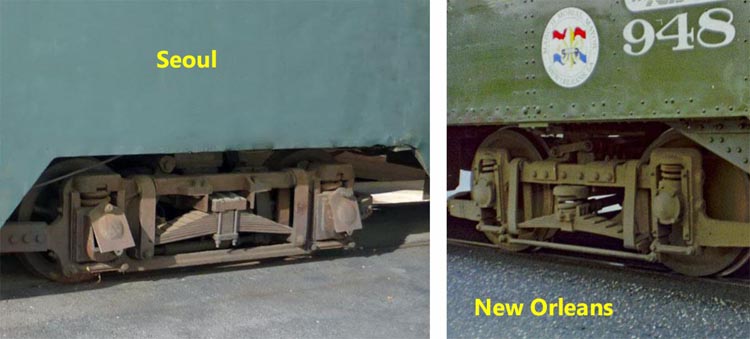
These two wheel bases are not identical, but it is clear that they have the same engineering ancestry. Japan's Mitsubishi copied the General Electric of the United States. They even copied the rhythm of the air coprocessor from GE.
- Do you know who started GE or the General Electric? This company was started in 1892 by John P. Morgan (with money) and Thomas Edison (with inventions). These days, this compnay makes jet engines, nuclear submarines, and just above everything Koreans cannot take over.
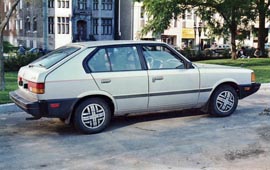
Hyundai car of 1986 in Canada.
There were no Korean-made cars
in the United States until 1988.- These days, Mitsubishi products are widely respected throughout the world. Our Hyundai cars used to be Mitsubishi copies, but they became their own. There are now many more Hyundai vehicles than Mitsubishi cars in the United States.
Mitsubishi also had its humble history of copying even the compressor rhythms from the General Electric of the United States, like other Japanese industrial giants. If you plan to buy a camera, Canon and Nikon are the two prominent names that come to your mind. They used to be the copies of Leica and Contax of German cameras respectively. Click here to see how Canon copied Leica. It is generally agreed that the copying game is now over for Japanese.
In our scientific research, there are many U.S.-trained researchers in Korea. We are indeed in an excellent position to copy the U.S. research system. If we wish to copy the Stanford system, we have enough people who know about Stanford. If we wish to copy AT&T, we have the AT&T people. The question is when we can be graduated from the copying stage.
- Do you know who invented the brake system based on compressed air? He was George Westinghouse.
Note added in 2013.
- Alas! When I was in Dalian (Daeryon) in April of 2013, I saw the Electric
cars looking exactly like the ones I used to ride before I left Seoul in
1954. Unlike those I saw in New orleans, some of the Seoul cars had six
doors, including two big doors in the middle. We used call them Oh-gata
(big shape) Jeon-Cha. I saw them in Dalian 59 years after I saw them
in Seoul. Chinese are different from us. They dislike Japanese more than
we do, but they do not mind using their stuff they left behind nearly
70 years ago.
- Click here for the webpage dedicated to the city of Dalian (Daeryeon).
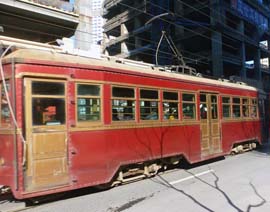
|